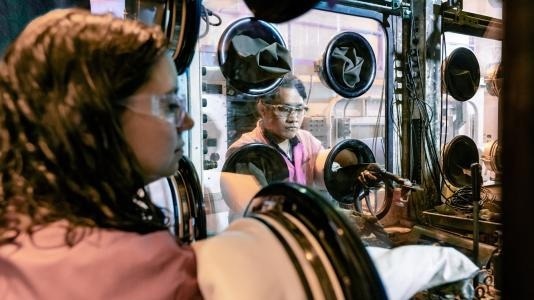Nuclear energy is produced using only a small portion of the energy contained in nuclear fuel. The remainder can be recovered and recycled to generate a large amount of electricity.

Engineers in Argonne’s Chemical and Fuel Cycle Technologies division will work with industry partners Oklo Inc. and Deep Isolation to increase the efficiency of the process used to convert UNF oxides to metals. They will do so using stable, next-generation anode materials and incorporating new process and product monitoring technologies. Image Credit: Argonne National Laboratory.
The Advanced Research Projects Agency-Energy (ARPA-E) of the United States Department of Energy (DOE) estimates that the underutilized energy available in used nuclear fuel, also known as spent nuclear fuel, can create enough clean energy to power more than 70 million homes.
ARPA-E recently awarded more than $6 million to DOE's Argonne National Laboratory to research and test novel techniques and technologies for recycling used nuclear fuel (UNF). The grant is made possible through the Converting UNF Radioisotopes Into Energy (CURIE) initiative.
Nuclear energy accounts for roughly one-fifth of overall electricity consumption in the United States, and it will generate half of the country’s carbon-free electricity by 2021.
Enhancing electrochemical separation and other UNF recovery and recycling technologies could enable nuclear energy to achieve greater efficiency. More effective nuclear energy utilization would reduce domestic reliance on fossil fuels and the associated greenhouse gases contributing to climate change.
It would cut waste while also creating new fuel for sophisticated reactors. This final benefit would result in deploying new sophisticated reactors, which would offer even safer, cleaner, and more reliable electricity.
ARPA-E funding will be used by Argonne to further two projects. The bigger initiative will bring together Argonne’s nuclear research and development expertise with nuclear industry partners Oklo Inc. and Deep Isolation. On both projects, Argonne will work with Case Western Reserve University.
The larger project received $4.9 million in funding. It aims to improve the efficiency and, thus, the economics of nuclear fuel recycling procedures. Argonne, Oklo Inc., and Deep Isolation are collaborating to improve a technique that transforms UNF oxide fuel into a metal, which can subsequently be processed to provide useful materials for enhanced reactor fuel.
To optimize the amount of material that can eventually be recovered, the research will combine advancements in stable, next-generation anode materials and sensors used to manage the process.
The work is led by Krista Hawthorne, the pyroprocess engineering section manager in Argonne’s Chemical and Fuel Cycle Technologies division.
Improving the efficiency of fuel recycling processes will help recover and recycle valuable resource materials remaining in used nuclear fuel. Our partnerships with ARPA-E and industry are incredibly important to closing remaining technology gaps.
Krista Hawthorne, Manager, Pyroprocess Engineering Section, Chemical and Fuel Cycle Technologies, Argonne National Laboratory
The second project received $1.52 million in funding. Argonne researchers will develop, manufacture, and test more effective industrial chemical processing equipment to reprocess UNF as part of this project. Anna Servis, an Argonne radiochemist, is in charge of the project.
Packed bed columns are used in cutting-edge facilities that reprocess light-water nuclear reactor fuels. Packed bed columns are tall canisters filled with packing material that mixes fluids that flow from one end to the other during chemical separations.
PACERs (PAcked Centrifugal Equipment for Radiochemical separations) are used instead in the design by Servis’ group. PACERs are rotating packed bed contactors that outperform columns in terms of efficiency.
They use centrifugal forces far stronger than gravity’s pull to increase the speed and efficacy of chemical separations. They are also significantly smaller. Consider replacing a water tower-sized packed bed column with a shed-sized PACER for scale.
Used nuclear fuel contains a treasure trove of raw materials, including energy-rich uranium that can be recycled into new fuel, precious metals and versatile radioisotopes. Mining our existing UNF stockpiles reduces demand for non-renewable minerals and conserves resources for future generations.
Anna Servis, Radiochemist, Argonne National Laboratory